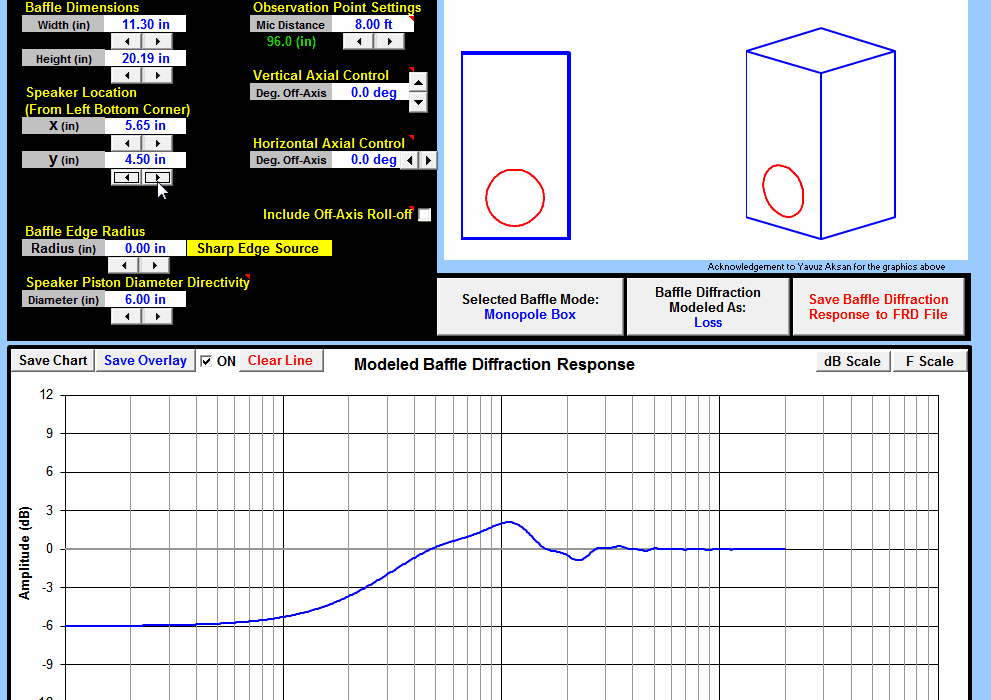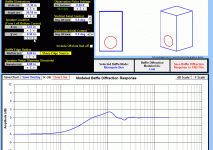I was thinking of adding the baffle response bit as well, but it was getting a bit long. I actually have another post which was written quite some time ago on baffle diffraction (I was writing a whole series and just ran out of steam). I can check with the other mods about whether to make it a sticky.
A title like "Why textbook or "pre-made" crossovers are not a good idea" would probably be good. an extract from the post on baffle step is below:
I'm starting to get motivated again to finish this series of posts. Hopefully it won't take me another 4 years!!
I did think about doing the full job on the post with minimum phase, offsets and baffle diffraction, but thought it probably better to just show the basics without overloading the newbie in the first post.
Tony.
A title like "Why textbook or "pre-made" crossovers are not a good idea" would probably be good. an extract from the post on baffle step is below:
Below is an animation of the changes in baffle step response with the driver moving up the baffle in the vertical plane. Jeff Bagbies Baffle Diffraction and Boundary simulator spreadsheet was used. You can see that depending on the placement the dips and peaks change quite a bit.

This gives us a pretty good idea of what sort of response anomalies the baffle is going to introduce. If we want an even better idea, we can spltrace the manufacturers curve and import it into Jeff's other spreadsheet the frequency response modeler, this may help us to fine tune the response to avoid worsening any natural dips in the drivers response or accentuating natural peaks. If we are really lucky we may be able to compensate for them.
Note that we can move the driver off centre as well and this will also have an effect on the baffle diffraction (usually smoothing it out). There are tradeoffs (as usual) in doing so, in that you will not get symmetrical off axis response. The baffle step can be dealt with (including humps) in the crossover, off axis irregularities will be best dealt with using room treatment or speaker placement. If you are considering non-central positioning of the drivers it would pay to do some research on what the pros and cons of doing so are.
I'm starting to get motivated again to finish this series of posts. Hopefully it won't take me another 4 years!!
I did think about doing the full job on the post with minimum phase, offsets and baffle diffraction, but thought it probably better to just show the basics without overloading the newbie in the first post.
Tony.
Attachments
Watch this space. I'm going to clean up a couple of posts from my series I was developing and put it on public view as a sticky. It will include the post 3 from this thread. One of the posts has information about tracing spl but the tool I used to demonstrate is no longer available so I have to re-do that one. Once done (hopefully within a couple of days) I'll put up what I have so far, and the rest will have to come as it comes.
Tony.
Tony.
Were you referring only to the crossover region?Whose job it it then?
OK I've put my work on public display. So you want to design your own speaker from scratch! It will be a work in progress for a while I suspect. I probably won't get a chance to do the next installment till next week sometime.
Tony.
Tony.
HFA transmision line monitors
I dont know if any of the older generation remember the high fi answers magazines transmision line monitors from about 1973 i think, i still have a pair i built but have been modified over the years they were a 4 way design, the coles super tweeters were the first to blow , they have ended up as a 3 way , the kef drivers have been replaced i think the tweeter and mid are peerless or seas now it's been a while? the b139 i replaced with a 12" driver it only just squeezed in with some jigsawing, the crossover was the uprated 100 watt one i think from wimslow audio and is still the same, it would be interesting to measure the response it's probably way out, but to my ears they sound great ,the bass is much better i thought the b139 was weak and the tweeter is sweeter than the old t27, the mid sounds better in phase the old 110 was out of phase on the x over for some reason, i still use them now , i hope i havn't gone off topic too much but to my ears i think they sound really good!
I dont know if any of the older generation remember the high fi answers magazines transmision line monitors from about 1973 i think, i still have a pair i built but have been modified over the years they were a 4 way design, the coles super tweeters were the first to blow , they have ended up as a 3 way , the kef drivers have been replaced i think the tweeter and mid are peerless or seas now it's been a while? the b139 i replaced with a 12" driver it only just squeezed in with some jigsawing, the crossover was the uprated 100 watt one i think from wimslow audio and is still the same, it would be interesting to measure the response it's probably way out, but to my ears they sound great ,the bass is much better i thought the b139 was weak and the tweeter is sweeter than the old t27, the mid sounds better in phase the old 110 was out of phase on the x over for some reason, i still use them now , i hope i havn't gone off topic too much but to my ears i think they sound really good!
^I was extremely happy with my three way speakers for many years. They started out quite differently to yours, but sounds like a similar journey. It was when I heard some $35,000 Infinity speakers in the early 90's that my illusions were shattered!! Up to that point all of the commercial speakers I'd heard I wasn't that interested in.
That is why now that I'm happy with my current speakers, I don't go out listening to anything high end, just in case I once again I find my speakers that I am currently happy with, lacking
Tony.
That is why now that I'm happy with my current speakers, I don't go out listening to anything high end, just in case I once again I find my speakers that I am currently happy with, lacking
Tony.
Until recently, I was overlooking the "voicing" of the speaker.
I was correcting my speakers with Dr. Toole's "flat" house curve. I was very happy with the sound, but I recently realized that I can make it more preferable by voicing speakers with BBC curve, which has 2dB dip around 2-5K. In fact, a lot of popular high end commercial consumer speakers use this curve according to Stereophile measurement. Easier to listen to, more Hi-Fi feel than Monitor feel.
I believe it's impossible to be tuned by ear without measurement, but it's also impossible to finish tuning without ear. 0.5dB difference at 2K, 2000Hz vs 2200Hz crossover point makes a huge subjective difference once the speaker gets closer to your ideal speaker.
I was correcting my speakers with Dr. Toole's "flat" house curve. I was very happy with the sound, but I recently realized that I can make it more preferable by voicing speakers with BBC curve, which has 2dB dip around 2-5K. In fact, a lot of popular high end commercial consumer speakers use this curve according to Stereophile measurement. Easier to listen to, more Hi-Fi feel than Monitor feel.
I believe it's impossible to be tuned by ear without measurement, but it's also impossible to finish tuning without ear. 0.5dB difference at 2K, 2000Hz vs 2200Hz crossover point makes a huge subjective difference once the speaker gets closer to your ideal speaker.
plasnu, Toole's recommendations are based on listener evaluations, but there is devil in details. It is very important to know a speaker's radiation pattern, DI through it's range. Different shape of DI gives different farfield/room response. BBC curve is usually seen in on-axis response at 1m, and speakers with dome tweeters.
I seem to end with very gently sloping room-response, which typically means recessed on-axis response at 2-5kHz. response above 8kHz is practically out of my hearing, but I can hear changes there too. If room response has a dip at 2-5kHz it means that 500-1kHz is too hard, sound is harsch and cold to me. A bit elevated bass-low mid gives lots of warmth and nearness, but very easily gets too thick and muddy. Lowest bass is surprisingly important too, smooth 20-50Hz adds space and ambience (when it comes from a sealed driver).
I have measured and listened to several my projects is various environments and learned to finally trust my ears more than measurements. When crossovers are basically OK and on-axis and off-axis response don't have sharp changes, voicing is easy with dsp or even with amplifier's bass/treble adjustment.
I seem to end with very gently sloping room-response, which typically means recessed on-axis response at 2-5kHz. response above 8kHz is practically out of my hearing, but I can hear changes there too. If room response has a dip at 2-5kHz it means that 500-1kHz is too hard, sound is harsch and cold to me. A bit elevated bass-low mid gives lots of warmth and nearness, but very easily gets too thick and muddy. Lowest bass is surprisingly important too, smooth 20-50Hz adds space and ambience (when it comes from a sealed driver).
I have measured and listened to several my projects is various environments and learned to finally trust my ears more than measurements. When crossovers are basically OK and on-axis and off-axis response don't have sharp changes, voicing is easy with dsp or even with amplifier's bass/treble adjustment.
Last edited:
Juhazi, thank you. Now you have made me remember that I was moving measurement mic here and there when I applied Toole's curve a few years ago, and was scratching my head wondering which mic position is the most trustful! LOL. I measured @1m this time with a bit more confidence.
- Home
- Loudspeakers
- Multi-Way
- Why simple crossovers, tuned by ear, don’t work

